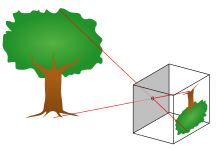
Most photographic lenses can be thought of as modified pinhole lenses. A pinhole lens would be excellent except for a few serious limitations. They are limited in their resolution because, while geometric optics says that making the pinhole smaller improves resolution, this also reduces the amount of entering light; furthermore, diffraction limits the effectiveness of shrinking the hole. Most photographic lenses can be thought of as an answer to the question "how can we modify a pinhole lens to admit more light and give higher resolution?" A first step is to put a simple convex lens at the pinhole with a focal length equal to the distance to the film plane (assuming the camera will take pictures of distant objects). This allows us to open up the pinhole a bit. The geometry is almost the same as with a simple pinhole lens, but rather than being illuminated by single rays of light, each image point is illuminated by a focused "pencil" of light rays. Standing out in the world, you would see the small hole. This image is known as the entrance pupil: all rays of light leaving an object point that enters this pupil will be focused to the same point on the film. If one were inside the camera, one would see the lens acting as a projector. The image of aperture is the exit pupil.
No comments:
Post a Comment